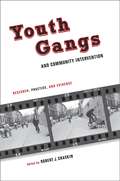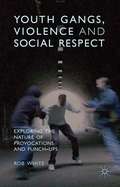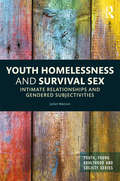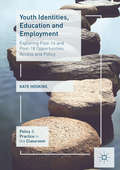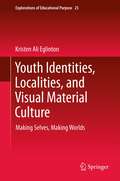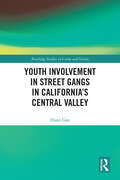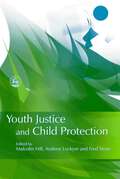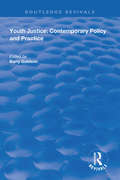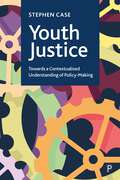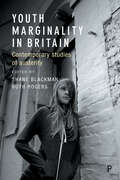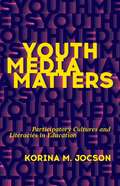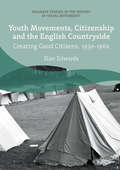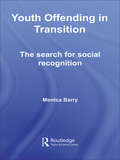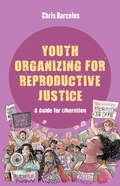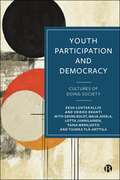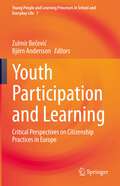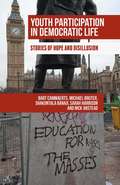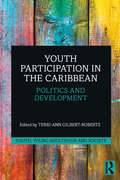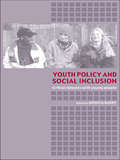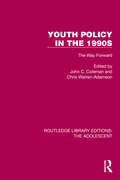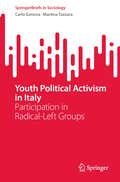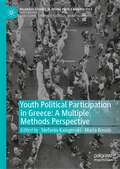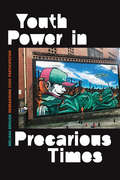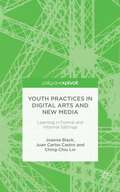- Table View
- List View
Youth Gangs and Community Intervention: Research, Practice, and Evidence
by Ed. Robert J. ChaskinAlthough a range of program and policy responses to youth gangs exist, most are largely based on suppression, implemented by the police or other criminal justice agencies. Less attention and fewer resources have been directed to prevention and intervention strategies that draw on the participation of community organizations, schools, and social service agencies in the neighborhoods in which gangs operate. Also underemphasized is the importance of integrating such approaches at the local level. In this volume, leading researchers discuss effective intervention among youth gangs, focusing on the ideas behind, approaches to, and evidence about the effectiveness of community-based, youth gang interventions. Treating community as a crucial unit of analysis and action, these essays reorient our understanding of gangs and the measures undertaken to defeat them. They emphasize the importance of community, both as a context that shapes opportunity and as a resource that promotes positive youth engagement. Covering key themes and debates, this book explores the role of social capital and collective efficacy in informing youth gang intervention and evaluation, the importance of focusing on youth development within the context of community opportunities and pressures, and the possibilities of better linking research, policy, and practice when responding to youth gangs, among other critical issues.
Youth Gangs, Violence and Social Respect
by Rob WhiteThis is the first book dedicated to Australian youth gangs, exploring the subtleties and nuances of street life for young men and their quest for social respect. It focuses specifically on group violence and the ways in which the 'gang' provides a forum for the expression of this violence. White argues that what happens on the street demands a holistic analysis which takes into account the interrelationships between class circumstance, masculinity, race and ethnicity. Gangs and gang violence are thus 'made' in the crucible of specific histories, specific neighbourhoods and specific social contexts. Based upon many years of research, and drawing upon the theoretical insights of international literature in this area, this book provides a sustained analysis and portrayal of youthviolence and youth gangs – one that includes and highlights the voices and viewpoints of the young people themselves.
Youth Homelessness and Survival Sex: Intimate Relationships and Gendered Subjectivities (Youth, Young Adulthood and Society)
by Juliet WatsonSurvival sex, commonly understood to be the exchange of sex for material support, is a practice that is associated with young homeless women. However, such a narrow definition of survival sex fails to recognise the multiple, complex, and coexisting motivations of young homeless women for engaging in intimate relationships in post-industrial capitalist society. In Youth Homelessness and Survival Sex, Watson’s insightful analysis of personal narratives reveals how young homeless women are exposed to situations in which survival can be impeded or assisted by playing out specific gender roles. Indeed, in identifying and contesting the dominant social discourses that young homeless women draw upon to frame their experiences of intimate affairs, Watson challenges the reader to understand how gendered subjectivities are produced and performed through heteronormative relationships. This enlightening book is vital in showing that homelessness is not a gender-neutral phenomenon and that there are gender-specific processes and practices involved in the navigation of poverty, violence, and social exclusion. Youth Homelessness and Survival Sex will appeal to undergraduate and postgraduate students, as well as postdoctoral researchers, interested in fields such as Homelessness, Youth Studies, Social Work, and Gender Studies.
Youth Identities and Argentine Popular Music
by Pablo Vila Pablo SemánThis book analyzes the music that young porte#65533;as/os (the inhabitants of Buenos Aires, Argentina) actually listen to nowadays, which, contrary to well-entrenched stereotypes, is not tango but rock nacional, cumbiaand romantic music. Chapters examine the music and what the Argentinean youth use it to say about themselves.
Youth Identities, Education and Employment
by Kate HoskinsThis book investigates how policy, family background, social class, gender and ethnicity influence young people's post-16 and post-18 employment and education access. It draws on existing literature, alongside new data gathered from a case study in a UK state secondary school, to examine how policy changes to the financial arrangements for further and higher education and the changing youth employment landscape have had an impact on young people's choices and pathways. Hoskins explores a number of topics, including the role of identity in young people's decision-making; the impact of changes to young people's financial arrangements, such as cuts to the Education Maintenance Allowance and increased university fees; and the influence of support from parents and teachers. The book will be of interest to students and researchers of Education and Sociology.
Youth Identities, Localities, and Visual Material Culture
by Kristen Ali EglintonThis invaluable addition to Springer's Explorations of Educational Purpose series is a revelatory ethnographic account of the visual material culture of contemporary youths in North America. The author's detailed study follows apparently dissimilar groups (black and Latino/a in a New York City after-school club, and white and Indigenous in a small Canadian community) as they inflect their nascent identities with a sophisticated sense of visual material culture in today's globalized world. It provides detailed proof of how much ethnography can add to what we know about young people's development, in addition to its potential as a model to explore new and significant avenues in pedagogy. Supported by a wealth of ethnographic evidence, the analysis tracks its subjects' responses to strikingly diverse material ranging from autobiographical accounts by rap artists to the built environment. It shows how young people from the world's cultural epicenter, just like their counterparts in the sub-Arctic, construct racial, geographic and gender identities in ways that are subtly responsive to what they see around them, blending localized characteristics with more widely shared visual references that are now universally accessible through the Web. The work makes a persuasive case that youthful engagement with visual material culture is a relational and productive activity that is simultaneously local and global, at once constrained and enhanced by geography, and possesses a potent and life-affirming authenticity. Densely interwoven with young people's perspectives, the author's account sets out an innovative and interdisciplinary conceptual framework affording fresh insights into how today's youth assimilate what they perceive to be significant. Supported by a wealth of ethnographic evidence, the analysis tracks its subjects' responses to strikingly diverse material ranging from autobiographical accounts by rap artists to the built environment. It shows how young people from the world's cultural epicenter, just like their counterparts in the sub-Arctic, construct racial, geographic and gender identities in ways that are subtly responsive to what they see around them, blending localized characteristics with more widely shared visual references that are now universally accessible through the Web. The work makes a persuasive case that youthful engagement with visual material culture is a relational and productive activity that is simultaneously local and global, at once constrained and enhanced by geography, and possesses a potent and life-affirming authenticity. Densely interwoven with young people's perspectives, the author's account sets out an innovative and interdisciplinary conceptual framework affording fresh insights into how today's youth assimilate what they perceive to be significant. Supported by a wealth of ethnographic evidence, the analysis tracks its subjects' responses to strikingly diverse material ranging from autobiographical accounts by rap artists to the built environment. It shows how young people from the world's cultural epicenter, just like their counterparts in the sub-Arctic, construct racial, geographic and gender identities in ways that are subtly responsive to what they see around them, blending localized characteristics with more widely shared visual references that are now universally accessible through the Web. The work makes a persuasive case that youthful engagement with visual material culture is a relational and productive activity that is simultaneously local and global, at once constrained and enhanced by geography, and possesses a potent and life-affirming authenticity. Densely interwoven with young people's perspectives, the author's account sets out an innovative and interdisciplinary conceptual framework affording fresh insights into how today's youth assimilate what they perceive to be significant.
Youth Involvement in Street Gangs in California’s Central Valley (Routledge Studies in Crime and Society)
by Huan GaoThis timely, insightful, and data-led book fills a gap in gang scholarship by examining gangs in rural areas, specifically focusing on youth gang activity.Incorporating information from interviews with 96 active youth gang members and associates in three of the rural counties of California’s Central Valley, this book provides an in-depth look at youth involvement in gang life in rural settings and addresses the underlying factors leading to the socialization of rural youths into gang life. The book documents the family and school life of youths living in rural communities and examines the process by which they are initiated into gang activity. It discusses their roles in various street gang organizations and their gang-related and non- gang-related illegal activities. It traces their experiences within the criminal justice system, from initial contacts with the police to juvenile court and juvenile corrections. Besides extensive interviews with the youths and official records collected from local criminal justice agencies, data from more than 300 surveys of community members, accompanied by extensive field research in local communities, provides groundbreaking insights into a wide spectrum of issues related to gangs in rural settings. While the Central Valley of California serves as the research site for this extensive work, its findings are equally relevant to other rural areas in the United States and in the larger global context.This volume will be of pivotal interest to students, scholars, and academics in the fields of criminology, criminal justice, sociology, law, social sciences, and political sciences, as well as policymakers, criminal justice practitioners, community leaders, and advocates for gang prevention and intervention programs.
Youth Justice and Child Protection
by Fred Stone Andrew Lockyer Malcolm HillThis book is an examination of recent developments in the areas of youth justice and child protection. It investigates how well young people and the societies in which they live are served by judicial and service systems. Consideration is given to those in care - in young offenders' institutions, foster families and residential homes - as well as those living with their families. A broad range of international experts discuss the largely segregated youth justice and children's legal and service systems in England and Wales, other parts of Western Europe and the US, and compare these with Scotland's integrated system. The implications of these arrangements are considered for the rights of children and parents on the one hand and society on the other. The contributors also provide insights into the rationale for current and proposed policies, as well as the efficacy of different systems. This book will be an important reference for policy-makers, social workers, lawyers, magistrates and equivalent decision makers, health professionals, carers, and all those working in youth justice and child protection. It is highly relevant for academics and students interested in children, citizenship, youth crime, child welfare and state-family relations.
Youth Justice: Contemporary Policy and Practice (Routledge Revivals)
by Barry GoldsonPublished in 1999, the aim of this text is to offer a critical analysis of contemporary policy and practice in relation to children and crime. It provides an integrated edited text combining a critical commentary of contemporary social/criminal justice policy with analyses of progressive practice in the UK. It offers coverage of each discrete stage in the processing of "child offenders" in the criminal justice system. It develops an alternative policy and practice framework drawing on experience from the UK, Europe, the USA, Canada, Australia and New Zealand.
Youth Justice: Towards a Contextualised Understanding of Policy-Making
by Stephen CasePolicy development and implementation has a pivotal role in the youth justice system, profoundly impacting professionals and the children they work with. This imaginative book challenges limited explanations of policy-making as linear and government-dominated through original research into the practices, identities and relationships of a wide range of stakeholders working in multiple policy- making contexts in England and Wales. The result is a detailed expert analysis of the contexts and mechanisms of youth justice policy-making. This book is key reading for researchers, professionals and students seeking effective understandings and responses to the long term social problem of youth offending.
Youth Marginality in Britain: Contemporary Studies of Austerity
by Shane Blackman and Ruth RogersTabloid headlines such as ‘Anti-social Feral Youth,’ ‘Vile Products of Welfare in the UK’ and ‘One in Four Adolescents is a Criminal’ have in recent years obscured understanding of what social justice means for young people and how they experience it. Youth marginality in Britain offers a new perspective by promoting young people’s voices and understanding the agency behind their actions. It explores different forms of social marginalisation within media, culture and society, focusing on how young people experience social discrimination at a personal and collective level. This collection from a wide range of expert contributors showcases contemporary research on multiple youth deprivation of personal isolation, social hardship, gender and ethnic discrimination and social stigma. With a foreword from Robert MacDonald, it explores the intersection of race, gender, class, asylum seeker status and care leavers in Britain, placing them in the broader context of austerity, poverty and inequality to highlight both change and continuity within young people’s social and cultural identities. This timely contribution to debates concerning youth austerity in Britain is suitable for students across youth studies, sociology, education, criminology, youth work and social policy.
Youth Media Matters: Participatory Cultures and Literacies in Education
by Korina M. JocsonIn an information age of youth social movements, Youth Media Matters examines how young people are using new media technologies to tell stories about themselves and their social worlds. They do so through joint efforts in a range of educational settings and media environments, including high school classrooms, youth media organizations, and social media sites. Korina M. Jocson draws on various theories to show how educators can harness the power of youth media to provide new opportunities for meaningful learning and &“do-it-together production.&” Describing the impact that youth media can have on the broader culture, Jocson demonstrates how it supports expansive literacy practices and promotes civic engagement, particularly among historically marginalized youth.In Youth Media Matters, Jocson offers a connective analysis of content area classrooms, career and technical education, literary and media arts organizations, community television stations, and colleges and universities. She provides examples of youth media work—including videos, television broadcasts, websites, and blogs—produced in the San Francisco Bay Area, Los Angeles, New York, and St. Louis. At a time when educators are increasingly attentive to participatory cultures yet constrained by top-down pedagogical requirements, Jocson highlights the knowledge production and transformative potential of youth media with import both in and out of the classroom.
Youth Movements, Citizenship and the English Countryside: Creating Good Citizens, 1930-1960 (Palgrave Studies in the History of Social Movements)
by Sian EdwardsThis book explores the significance and meaning of the countryside within mid-twentieth century youth movements. It examines the ways in which the Boy Scouts, Girl Guides, Woodcraft Folk and Young Farmers' Club organisations employed the countryside as a space within which 'good citizenship' - in leisure, work, the home and the community - could be developed. Mid-century youth movements identified the 'problem' of modern youth as a predominantly urban and working class issue. They held that the countryside offered an effective antidote to these problems: being a 'good citizen' within this context necessitated a respectful and mutually beneficial relationship with the rural sphere. Avenues to good citizenship could be found through an enthusiasm for outdoor recreation, the stewardship of the countryside and work on the land. However, models of good citizenship were intrinsically gendered.
Youth Offending in Transition: The Search for Social Recognition
by Monica BarryTaking a new approach to youth crime, this book argues that the transition from childhood to adulthood can be an isolating and disempowering experience for young people. Children and young people are inherently vulnerable because of their age and status – they are a minority group, with the potential for being exploited, discriminated against, dominated and disrespected by adults. Youth Offending in Transition explores how their treatment by adult society may lead young people to resort to crime as a means of gaining respect from their peers. Using concepts of capital and the narratives of young offenders themselves, this book is based on original research into the reasons why young people start and stop offending. It discusses the following topics: criminal theory and the significance of youth transitions to the ‘age-crime curve’ social identity and reputation amongst young people social inequalities and their influence on youth transitions the criminalization and discrimination of young people by adults the importance of social recognition in reducing offending.
Youth Organizing for Reproductive Justice: A Guide for Liberation (Reproductive Justice: A New Vision for the 21st Century #11)
by Chris BarcelosThis helpful how-to guide introduces the practices, history, and politics of youth movements for justice in the United States Grounded in the struggles and worldmaking of queer and trans youth and people of color, Youth Organizing for Reproductive Justice shows us how all youth organizing is reproductive justice as young people resist systems of oppression that limit bodily autonomy and self-determination. Through case studies, activist spotlights, and organizing "how-tos," this book provides a powerful tool for understanding the interconnected struggles at the center of youth activism. From the school-to-prison pipeline to transgender youth’s access to gender-affirming care to support for pregnant and parenting teens, Chris Barcelos shows that reproductive justice inspires political organizing across a range of issues. This book will help mobilize scholars, activists, policy makers, reproductive justice nonprofit workers, and youth organizers toward collective liberation.
Youth Participation and Democracy: Cultures of Doing Society
by Eeva Luhtakallio Veikko ErantiHow do young people participate in democratic societies? This book introduces the concept of ‘doing society’ as a new theory of political action. Focused on Finnish youth, it innovatively blends cutting-edge empirical research with agenda-setting theoretical development. Redefining political action, the authors expand beyond traditional public-sphere, scaling from formal to informal and unconventional modes of engaging. The book captures diverse engagement from memes to social movements, from participatory budgeting to street parties and from sleek politicians to detached people in the margins. In doing so, it provides a holistic view of the ways in which young people participate (or do not participate) in society, and their role in cultural change.
Youth Participation and Learning: Critical Perspectives on Citizenship Practices in Europe (Young People and Learning Processes in School and Everyday Life #7)
by Björn Andersson Zulmir BečevićThis book contributes to the studies on learning processes occurring outside “traditional” socialization settings such as family and school, by analysing civic and political participation and learning experiences. In this perspective, the book delves into the connections between the concepts of learning and participation and, in various ways and from different perspectives, critically interrogates learning and participation as interrelated phenomena, with the aim of revealing complexities implicated in pathways to adulthood. Being interdisciplinary in its nature (contributors come from disciplinary backgrounds such as educational sciences, child and youth studies, social work, sociology and political science), the volume provides an up-to date analysis of contemporary issues connected to youth participation and learning. The work taps into central areas of everyday life of young people and youth meaning-making and generates and presents qualitative knowledge about what it means to be young in Europe today.
Youth Participation in Democratic Life: Stories of Hope and Disillusion
by Sarah Harrison Shakuntala Banaji Michael Bruter Bart Cammaerts Byrt Nick Anstead WhitwellThis book is concerned with the contexts, nature and quality of the participation of young people in European democratic life. The authors understand democracy broadly as both institutional politics and civic cultures, and a wide range of methods are used to analyse and assess youth participation and attitudes.
Youth Participation in the Caribbean: Politics and Development (Youth, Young Adulthood and Society)
by Gilbert-Roberts, Terri-AnnCritically examining narratives of participation in governance and development, this volume adds Caribbean voices and experiences to the global discourse on youth participation. The essays provide empirical case studies of institutions, practices and processes of youth engagement in the politics of Caribbean development, orienting the reader to the political culture of the Caribbean and the position of youth within small societies. Covering experiences at intergovernmental, national and local levels, as well as formal and informal modes of participation, it examines how young people have organised themselves or have been organised to engage with the state and with community agents in politics, public policy and activism. It illustrates the heterogeneity of youth political participation, employing multi- disciplinary, multi- level and mixed- method analyses from the fields of demography, political science, social policy, development studies and youth development. Critical themes addressed include regional governance, democratic representation, online engagement, local governance and community development. In exploring these themes, the book discusses the legitimacy and inclusiveness of governance in relation to age, gender, race, geography and socio-economic status. The findings will be useful to students, researchers and policymakers alike who are keen to improve governance and contribute to inclusive sustainable development in the Caribbean.
Youth Policy and Social Inclusion: Critical Debates with Young People
by Monica BarryTaking a holistic and multidisciplinary approach this book identifies and analyzes the factors which promote or discourage social inclusion of young people in today’s society. It critically examines the discriminatory attitudes towards young people, and focuses on the 'problem' of adults rather than the 'problem' of young people themselves. The authors ask searching questions about society's capacity and willingness to be more socially inclusive of young people in terms of policy and practice, and explore the extent to which young people have access to status, rights and responsibilities as young adults. Challenging existing theory the book covers issues including: citizenship, education, rights, youth transactions, drug use, homelessness, teenage pregnancy and unemployment. Incorporating the views and experiences of young people themselves, the book highlights the strengths and weaknesses of the academic contribution and suggests ways forward for a more inclusive society.
Youth Policy in the 1990s: The Way Forward (Routledge Library Editions: The Adolescent)
by John C. Coleman Chris Warren-AdamsonDespite its importance, youth policy is an often-ignored area of Government planning and legislation, and policy initiatives seem to lack any guiding theme or relevance to the needs of young people. In Youth Policy in the 1990s originally published in 1992, the editors brought together prominent experts in the key areas of youth policy at the time. They provide a critical review of the major issues which implicitly or explicitly affect the world of adolescents and examine to what extent they paint a picture of existing youth policy. The aim was to provide a baseline for a policy on youth in the 1990s. The book recommends the introduction of a Minister for Young People and the use of youth impact statements at national and local level and seeks to provide information and argument for those seeking to plan policy for young people from a corporate or inter-agency perspective. The contributors are all recognized experts in their fields. They tackle their topic first by examining the historical perspective, with a special concentration on the previous decade. Each has paid regard to particular themes – ethnicity, class and gender, and where possible, has brought in material from other countries and cultures. They have then put forward suggestions for future policy.
Youth Political Activism in Italy: Participation in Radical-Left Groups (SpringerBriefs in Sociology)
by Carlo Genova Martina TazzaraThis book asks readers to rethink youth activism in the political field as a lifestyle whose sense goes beyond the logic of political action. Reviewing the debate on the relationship between young people, politics and political participation, it shows that a significant portion of young people are involved in more social forms of participation, rather than with political ones, because their references to political values and ideologies, as well as their trust in political actors, are weak. But, in parallel, it also challenges the hypothesis that the various ways in which young people are present in the political sphere can be considered simply as forms of political participation. Presenting the results of research on young activists from radical-left groups in Italy, the book shows that their involvement is only partly attributable to reasons of political intervention; instead, desires for experimentation and self-expression, as well as shared tastes and sensibilities that far exceed the boundaries of the political, characterize their participation, and are therefore a component of a broader, distinctive lifestyle. Based on these findings, the book calls for a rethinking of youth engagement, the reasons for which could be largely outside the field of politics.
Youth Political Participation in Greece: A Multiple Methods Perspective (Palgrave Studies in Young People and Politics)
by Maria Kousis Stefania KalogerakiThe overarching aim of this edited volume is to investigate different modes, patterns and determinants of youth political participation in Greece, since the economic crisis, by incorporating a variety of quantitative and qualitative methods. The chapters examine different forms of youth political participation, from institutionalized (such as voting, or membership in political parties) to non-institutionalized (such as signing petitions, protesting through demonstrations or occupations, and political consumerism). Moreover, the chapters shed light on diverse aspects of youth political participation, such as the interlinkages between occupational precarity and political behaviour, the spatial portrait of youth political engagement in rural, suburban and urban Greek contexts, the engendered aspects of political involvement, the pivotal role of protest events in youth political socialization and in mobilization in contentious political actions, the different impacts of priming inequality on youth’s political beliefs, depending on different modes of thinking, as well as the key features of youth-related and youth-led (non-state) organisations operating in Greece. The aforementioned aspects are examined at the micro, meso or/and macro level through distinct methodological approaches including panel survey, experimental survey, biographical interviews, in-depth interviews and action organization analysis, carried out in the context of the EURYKA (European Commission) project.
Youth Power in Precarious Times: Reimagining Civic Participation
by Melissa BroughDoes youth participation hold the potential to change entrenched systems of power and to reshape civic life? In Youth Power in Precarious Times Melissa Brough examines how the city of Medellín, Colombia, offers a model of civic transformation forged in the wake of violence and repression. She responds to a pressing contradiction in the world at large, where youth political participation has become a means of commodifying digital culture amid the ongoing disenfranchisement of youth globally. Brough focuses on how young people's civic participation online and in the streets in Medellín was central to the city's transformation from having the world's highest homicide rates in the early 1990s to being known for its urban renaissance by the 2010s. Seeking to distinguish commercialized digital interactions from genuine political participation, Brough uses Medellín's experiences with youth participation—ranging from digital citizenship initiatives to the voices of community media to the beats of hip-hop culture—to show how young people can be at the forefront of fostering ecologies of artistic and grassroots engagement in order to reshape civic life.
Youth Practices in Digital Arts and New Media: Learning in Formal and Informal Settings
by Joanna Black Juan Carlos Castro Ching-Chiu LinThe authors examine youths' practices in digital culture affecting social change, pedagogy, and creative learning practices. Knowledge about these practices is discussed, in which learning, knowledge sharing, distinct social contexts, pedagogical relationships, and artistic creative inquiry are examined in diverse formal and informal environments.
